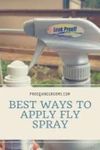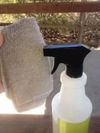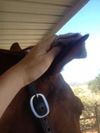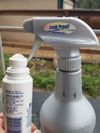

Sometimes wiping fly spray is better than spraying.

This fly spray is made from fatty acids, and works by confusing some flies about where the horse is. Smells weird, but works really well.

It's never a good idea to spray your horse's face directly. Instead, use a sponge, towel, or your hand

Roll on fly protection is great for your horse's sensitive areas.

What about the sensitive areas around my horse’s face? That’s where the bugs like to hang out.
Fly control sprays, roll-ons, and lotions have a few things in common - there is a right way and wrong way to use them. Here’s how to make the most of your favorite fly control product:
Use fly control products on a clean horse. If you must spritz a dirty or dusty horse, I’m totally okay with that, just know that you may need to re-apply after a grooming session.
Read the label and the instructions! Each formula is different, and each manufacturer will have the best practices on the label. Get your dollars worth and follow the labels for best performance. If you are interested, this article can help you decipher some of the many ingredients you may find in a bottle of fly spray for horses.
It may be best to tack up before you spray your horse’s body. Your tack could slip (bad) or the sweat/heat/fly spray/trapped under a saddle could cause a skin reaction (also bad). If you are worried about the fly spray on your saddle, just leave your saddle cover on as you spray.
Fly sprays + horse faces don’t always equal harmony. Horses can be very protective of their ears, eyes, and noses (rightly so) and having your horse stand in cross ties as you squirt them with fly spray can lead to an accident or head shyness. Instead, here are a few ideas to make this process practically invisible to your horse.
Know the best places to apply fly protection to your horses face: ears, down the blaze, and under the eyes. I don’t recommend using fly spray, fly gel, or fly roll-on above the eyes, and sweat can create a spray/sweat drip into his eyes.
Use something besides the sprayer to apply fly spray. Spray a washcloth, a grooming mitt, a paper towel, your hand, etc and use that to wipe on your horse’s ears, down his face, and very carefully under his eyes. When I say under his eyes, I still mean far away from any sensitive areas, at least an inch or so away from the eye.
You could also spritz your soft face brush and apply fly protection as you groom.
If you use a fly bonnet when you are riding, you can spritz the bonnet before you put it on to help with those annoying gnats that tend to form a “cloud”.
Wash your hands after handling fly spray and before you handle any horse treats. Or treats for you.
Don't touch a cat after using a fly spray with permethrins or pyrethrins. Totally toxic and usually deadly.

